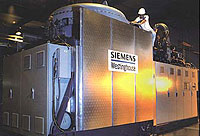In his new book, The Hydrogen Economy, Jeremy Rifkin argues that throughout history, the use of energy has determined the rise and fall of civilizations. In this analysis, a civilization is successful until it begins spending more of its energy supply to maintain its infrastructure than to enhance the lives of its citizens. For example, ancient Rome began to falter when it expanded its domain at the expense of the health and welfare of its people, exploiting slaves, practicing unsustainable agriculture, and exhaustively felling forests for firewood.

The Hydrogen Economy
By Jeremy Rifkin
Tarcher/Putnam,
336 pages, 2002
Later, the burning of coal, gas, and oil ushered in the industrial era — the age of fossil fuel. Now, writes Rifkin — author of several books of social criticism and president of the Washington, D.C.-based Foundation on Economic Trends — we are approaching a time when the pursuit of increasingly scarce supplies of petroleum may cause a “series of breakdowns in systems … across the spectrum of modern life.” To avert such a crisis, says Rifkin, we must usher in a new energy age, one in which hydrogen will replace the hydrocarbons of fossil fuels.
The success of contemporary civilization in a world dominated by American-style capitalism depends on the steady supply of relatively inexpensive energy. Most of that energy now comes from fossil fuels. According to Rifkin, U.S. oil production peaked in the 1970s; since then, we have become increasingly reliant on oil from the Middle East. Our current “highly centralized, hierarchical energy infrastructure, and accompanying economic infrastructure,” Rifkin writes, makes for a precarious and potentially unstable situation, especially when coupled with the social and political differences between oil-producing Muslim countries and the United States and other Western nations.
The solution to this dilemma, writes Rifkin, is to accelerate our transition to a hydrogen economy. In his vision, the hydrogen economy will be one in which power, generated by myriad fuel cells, is delivered by decentralized networks, a system analogous to the World Wide Web. Power sources will be locally — and often publicly — owned and operated. This “democratized energy web,” as Rifkin calls it, would exist in the form of small individual power plants in homes and businesses. It would alter the current balance of our power structure, both literally and figuratively. The web would mean that the world’s growing number of energy users would no longer be vulnerable to the fortunes of a handful of enormous corporations and their diminishing, hard-to-reach sources of raw energy. While Rifkin describes the research and regulatory groundwork being laid to enable such a change, he does not detail the many practical hurdles confronting such a dramatic transition — or how to overcome them.

Fuel cell power.
Photo: National Energy
Technology Laboratory.
Conversion to a hydrogen rather than hydrocarbon-burning energy regime would have environmental advantages. Among other things, it would help decrease emissions of carbon dioxide and other gases that contribute to global warming, and curb the pollution generated by extracting and processing fossil fuels. Curiously, the scenario Rifkin lays out in The Hydrogen Economy seems to assume that current rates of consumption will continue, leading to an ever-escalating demand for energy. That we might live as well or better while conserving and using energy more efficiently is not addressed, either for fossil fuels or for the projected hydrogen economy.
The hydrogen power network Rifkin envisions would require a substantial new infrastructure — hydrogen fueling stations, a revamped electrical grid that enables hydrogen fuel-cells in cars and homes to send energy into the power system — as well as considerable revision of existing energy delivery systems. To make hydrogen financially and environmentally persuasive, we would also need to find cleaner, cheaper ways of producing fuel cells than those currently available. Rifkin describes these changes in broad strokes, but does not detail how the shift to hydrogen fuel cells will be achieved. For readers interested in an informative overview of how energy use has influenced the evolution of civilization, The Hydrogen Economy is a handy reference. But of the book’s nine chapters, only the last two address how a hydrogen economy would actually work, so readers eager for specifics on the political, technological and business strategies that will produce the “life affirming and regenerative” future Rifkin sees in a hydrogen economy may grow impatient; in the end, they’ll have to look for answers elsewhere.


